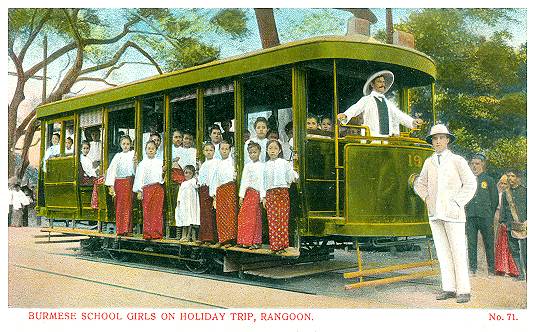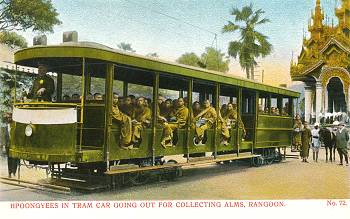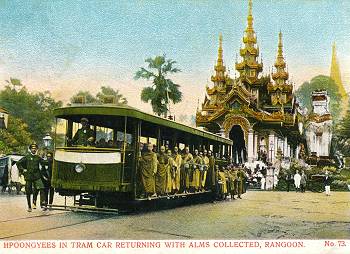

Here is a series of three cards printed in Germany from publisher D.A.Ahuja of Rangoon. The views were taken around 1908 (two of our cards were posted in 1909) close by the Shwedagon Pagoda in Rangoon (Yangon), the capital of Burma (Myanmar) in south-east Asia. Our main view is card No. 71 titled "Burmese school girls on holiday trip". It shows tram 19, a 4-wheel car. Card No. 72 below is titled "Hpoongyees in tram car going out for collecting alms". This is a bogie tram and the white banner on the dash is thought to be an indication that the car was a special. The final view is of card No. 73, titled "Hpoongyees in tram car returning with alms collected". Hpoongyees are Buddhist priests who subsist solely on the collection of alms. The impressive building in the background of the small views is the south gate of the Shwedagon Pagoda, the pagoda itself being the golden spire in the background of card No. 73. The Pagoda complex was lit by electricity supplied by the tramway company.
 The first tramways in Rangoon consisted of three standard gauge routes of the Rangoon Steam Tramway Company, which opened on 4th March 1884. Steam trams and trailers were from the Falcon Engine & Car Works Ltd. of Loughborough. The steam tramway company was owned by J.W.Darwood & Co., Rangoon dealers of wood and horses. In 1889 John Darwood, of Scottish decent, sold the steam tramway to a Calcutta based company, but by 1899 the operation had become bankrupt. By 1902 the canny Darwood bought a 42-year concession for electric tramways and lighting. In 1905 he registered the Rangoon Electric Tramway & Supply Company Ltd. in Liverpool, with a share issue in 1906 of £500,000. Having transferred his concession to the new company, Darwood then took a seat on the board. The first electric trams operated on 15th December 1906 with the last of the new routes opening on 12th March 1908. This brought the total of the system to five routes and 18.5 miles, with offices, depots and a generating station (which also provided power for local electric lighting) in Lower Kemmendine Road, Ahlone, to the west of the system.
The first tramways in Rangoon consisted of three standard gauge routes of the Rangoon Steam Tramway Company, which opened on 4th March 1884. Steam trams and trailers were from the Falcon Engine & Car Works Ltd. of Loughborough. The steam tramway company was owned by J.W.Darwood & Co., Rangoon dealers of wood and horses. In 1889 John Darwood, of Scottish decent, sold the steam tramway to a Calcutta based company, but by 1899 the operation had become bankrupt. By 1902 the canny Darwood bought a 42-year concession for electric tramways and lighting. In 1905 he registered the Rangoon Electric Tramway & Supply Company Ltd. in Liverpool, with a share issue in 1906 of £500,000. Having transferred his concession to the new company, Darwood then took a seat on the board. The first electric trams operated on 15th December 1906 with the last of the new routes opening on 12th March 1908. This brought the total of the system to five routes and 18.5 miles, with offices, depots and a generating station (which also provided power for local electric lighting) in Lower Kemmendine Road, Ahlone, to the west of the system.
 The initial rolling stock consisted of 4-wheel and larger 8-wheel cars, both having a closed saloon at one end and cross-bench seats at the other. Cars were supplied by the Brush Electrical Engineering Company Ltd. of Loughborough (successors to Falcon) and by the United Electric Car Company Ltd. of Preston. Records show that 41 cars were supplied from Preston. During the 1920's the company built some bogie cars themselves on Brill 39E trucks and in the same period constructed about 40 new centre entrance bodies for the earlier 4-wheel cars. One batch of cross-bench car bodies came from Les Ateliers Métallurgiques of Nivelles, Belgium.
The initial rolling stock consisted of 4-wheel and larger 8-wheel cars, both having a closed saloon at one end and cross-bench seats at the other. Cars were supplied by the Brush Electrical Engineering Company Ltd. of Loughborough (successors to Falcon) and by the United Electric Car Company Ltd. of Preston. Records show that 41 cars were supplied from Preston. During the 1920's the company built some bogie cars themselves on Brill 39E trucks and in the same period constructed about 40 new centre entrance bodies for the earlier 4-wheel cars. One batch of cross-bench car bodies came from Les Ateliers Métallurgiques of Nivelles, Belgium.
In 1920, Tramway & Railway World reported that the company was to transfer its control and central management from the United Kingdom to Burma, to avoid having to pay income tax in both countries. Relief in next financial year was expected to be between £10,000 and £15,000. In 1936 and 1938 the company introduced two trolleybus routes using Sunbeam and Ransomes vehicles respectively and then decided to replace the trams by trolleybuses. The trolleybus fleet increased to 63 and two tram routes were converted. War then intervened. In 1942 the Japanese invaded and then occupied Burma. The outgoing British forces blew up the tramway generating station at Ahlone and the tramway was much damaged by the Japanese air raids. Trams never ran again although for a short period in 1943 a few trolleybuses were operated, taking power from the municipal generating station, which had been damaged by the Japanese but subsequently repaired until again destroyed by them on their retreat. After the war the Ahlone generation station was reconstructed and did briefly supply electricity, but was nationalised in 1953. The tramway company was finally legally wound up in 1961
![]() Go to Postcard Of The Month Index
Go to Postcard Of The Month Index